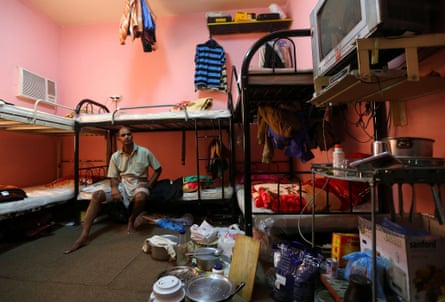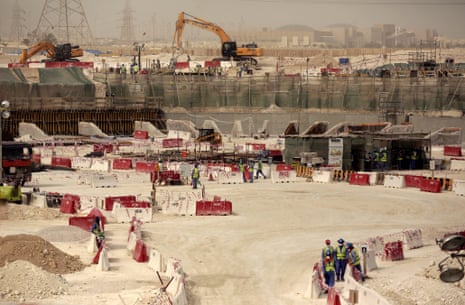The report commissioned by the Qatari government in the wake of the international outcry that followed the Guardian’s investigation into the plight of migrant workers in the tiny Gulf state made 62 recommendations grouped into nine key areas. The comprehensive report, produced by the international law firm DLA Piper, was never formally published, but human rights groups say they have been told by the government that it plans to implement the recommendations in full.
“We were told by the government that they are implementing the DLA Piper report but there is no clarity about how, when and who is responsible,” said James Lynch, who was Amnesty’s Middle East researcher when the report was released. One of the recommendations within the report was the suggestion that a follow-up should be published 12 months later detailing progress, but a spokesman confirmed on Wednesday that no such update had been prepared.
One source who was familiar with the drawing up of the report summarised the response so far by saying: “At the state level it is a case of chipping away around the edges on welfare rather than engaging on any of the major issues.”
The Qatari authorities say they remain committed to delivering meaningful reform but that it will take time, and they refuse to be held to a specific timetable.
Recruitment
The report recommended that Qatar strengthen and enforce laws preventing recruitment agencies from charging fees. It urged the authorities to go further and prohibit employers from dealing with any fee-charging recruitment agencies in countries of origin. This would attempt to deal with the middlemen who charge large fees and over-promise to impoverished workers, leaving them trapped in debt. Nepal and Qatar have made it illegal for agencies to charge large fees, but the practice continues unabated. Last September, the authorities said they had launched an inspection drive targeting the recruitment agencies of domestic workers. But when the Qatari minister for labour visited Kathmandu in April, he was lobbied by Nepalese officials to implement better insurance policies and require employers to pay any fees illegally charged by recruitment agencies.
Kafala sponsorship system
Human rights groups have long called for fundamental reform of the kafala system in Qatar and its neighbouring Gulf states, believing it underpins a form of modern slavery. The DLA Piper report recommended a “wide ranging and comprehensive review” of kafala with a view to abolishing or phasing out “certain aspects” of the system and prioritising freedom of movement and the rights of workers. It said that “over time” it should be abolished altogether. But in the 12 months since the report, there has been no change. The alternative of a five-year limit, proposed by the Qataris, which led some to report that kafala would be abolished, has been criticised by human rights groups. They believe that tying employees to their employer for up to five years will, in effect, codify the practice under another name. Meanwhile, an increase in labour inspectors has led to existing laws prohibiting the confiscation of passports being better enforced. However, critics wants stiffer penalties for those who fail to comply.
Exit permits
This is another area where the government has promised reforms but there is no timetable for delivery. The proposed changes do not go as far as human rights groups wanted in abolishing the system, which allows employers to prevent their employees from leaving Qatar altogether. Under the proposed changes, an employee would be free to leave the country but employers would have up to 72 hours to apply to block their departure if they had reasonable grounds. However, in the past 12 months there has been no further detail on how the proposed law would work or a timetable for its introduction.

Contracts
The report said worker welfare standards, such as those introduced in February 2014 by the Qatar 2022 World Cup organisers, should be made mandatory in all contracts issued by public authorities. Similar standards have been introduced by the Qatar Foundation, a not-for-profit state funding arm responsible for several major infrastructure projects. But so far there is little sign of similar standards being introduced more widely. A parallel recommendation to introduce rules to make lead contractors responsible for compliance through their web of subcontractors – which would go a long way to making major global construction firms responsible for those at the bottom of the chain – has not led to any progress.
Wages
The report calls for consideration to be given to introducing a minimum wage but the ministry for labour has confirmed that such a move is not on the agenda. Shortly before the DLA Piper report came out Qatar announced a new system for the automatic payment of wages electronically, seen as a positive change. Under the amendment to the labour law in February, businesses were given six months to comply. But the changes will only benefit those who receive a regular salary, not those without a formal contract.
Health and safety
The DLA Piper report called for contractors who breached health and safety standards to be blacklisted and for the introduction of stronger criminal sanctions, as well as joint liability for contractors (often major western companies) and their sub-contractors. Again, those on the ground say there is little to report. There have been some practical changes, such as the legal requirement to provide an onsite nurse for every accommodation block that houses 100 workers or more, and new rules increasing the minimum amount of space for each worker by 50%.
Reporting
The Qatari authorities have long argued that death figures for migrant workers paint an incomplete picture because they fail to take into account how they were killed or compare them with rates in other countries. But a key recommendation from the DLA Piper report – the regular collection and reporting of statistics regarding work-related injuries and deaths, to be published anonymously every six months – has yet to be enacted. In light of apparently unusually high levels of heart attacks, DLA Piper also called for an independent study into sudden cardiac arrests over the next three years and for there to be proper investigations into unexpected or sudden deaths. No such studies have been announced, despite Qatari officials insisting they are committed to collating and investigating such figures.
Accommodation
Recommendations included a mandatory induction for new employees, a worker welfare officer on every site, better monitoring and inspection, and better complaints procedures. The Qataris point to increased numbers of inspectors and the imminent construction of vast new accommodation complexes as evidence they are determined to improve conditions. But with Qatar’s 1.6 million migrant workers expected by the government to swell to 2.5 million over the next five years, it remains unclear whether it will be possible to raise standards fast enough to keep pace.
Inspections
Qatar has claimed that the number and frequency of inspections has increased but DLA Piper said more needed to be done so that the labour inspections department could perform its task with “sufficient coverage and rigour”. It wanted better training for inspectors, more powers, more interpreters for worker interviews and more transparency. The Qataris insist that the increased number of inspectors is starting to have the desired effect, but widespread examples of mistreatment on the ground remain. It increased the number of inspectors from 200 to 243 last year, but critics say this is far from enough.
